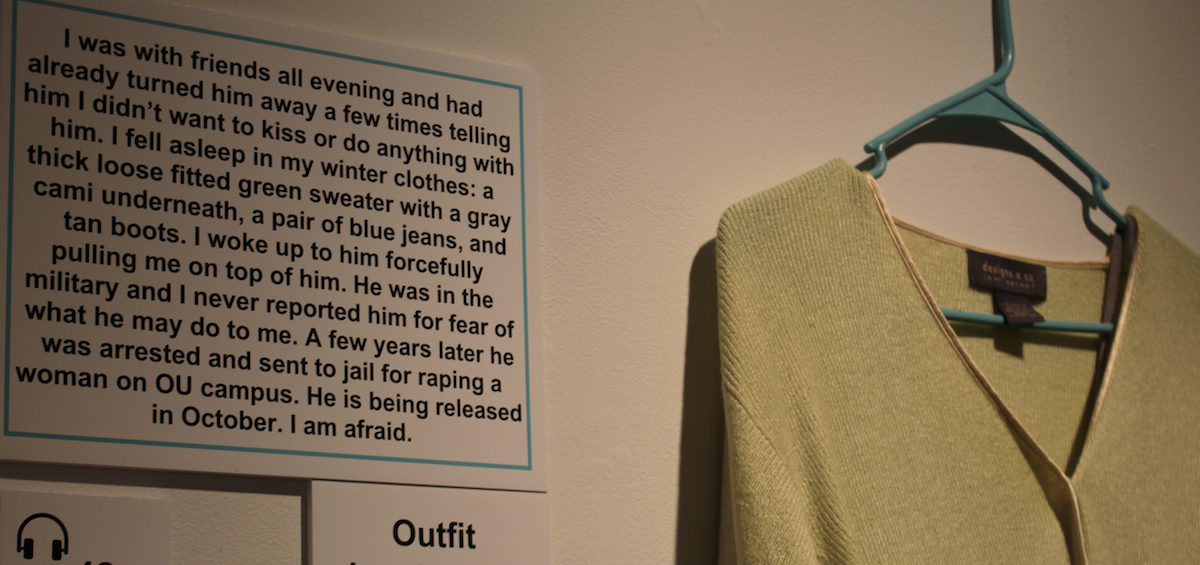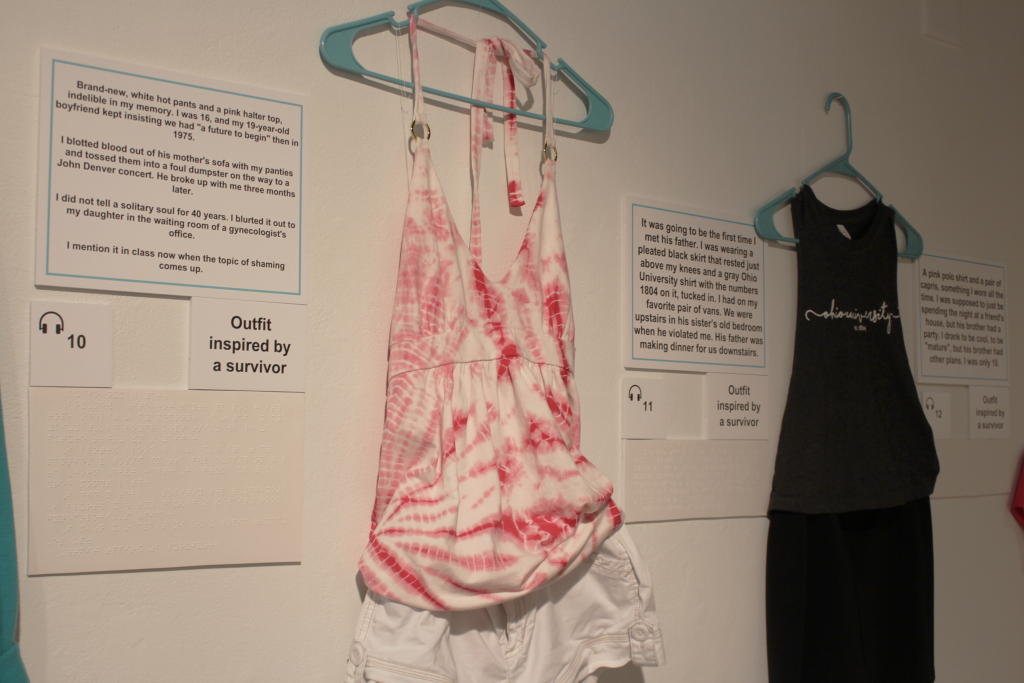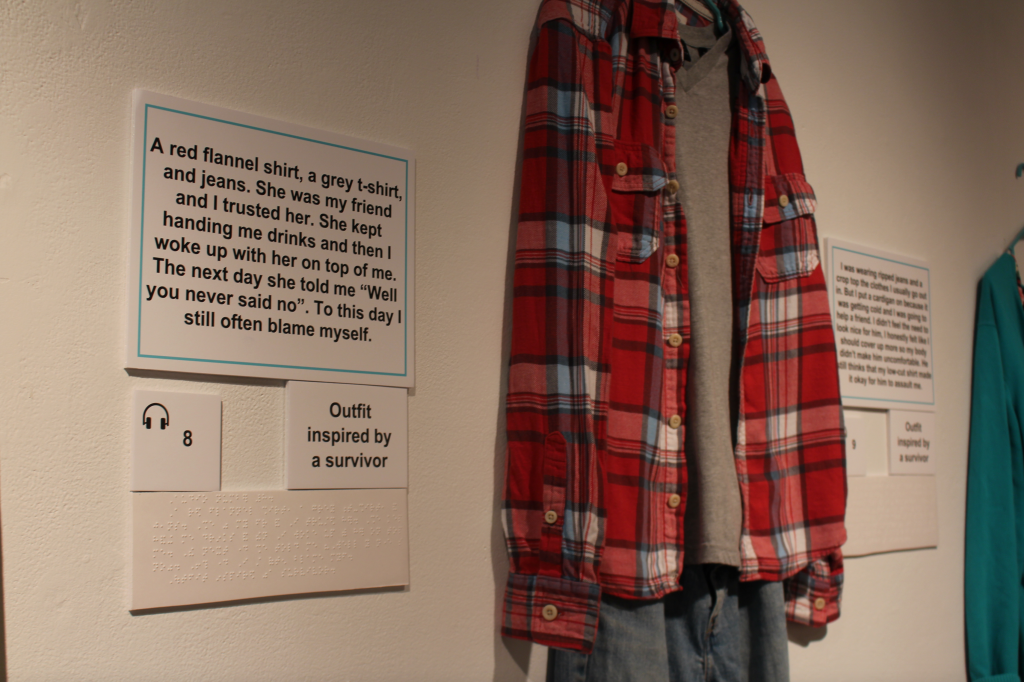Culture

‘What Were You Wearing?’ Exhibition Spotlights Survivor’s Stories
By: Rachael Beardsley
Posted on:
Since August 30, the walls of Baker Center’s Trisolini Gallery have been adorned with outfits of varied sizes, shapes and colors. Placed against a stark white background, the seemingly unrelated outfits are united for one reason: they are all replicas of what someone was wearing during a sexual assault. Together, they serve as part of an art exhibit aiming to question the harsh victim-blaming that often follows incidents of sexual violence.
The What Were You Wearing? survivor art installation features stories of sexual violence, all of them shared by students, faculty and staff of Ohio University and members of the surrounding communities. Accompanying each story is a display of clothing, gathered by event supervisors, that closely mirrors the outfit worn by the victim during the assault.
“One of the things that we wanted to do was to create an opportunity for our constituents to provide their experience and stories,” said Dr. M. Geneva Murray, director of the Ohio University Women’s Center. “So we collected, starting in March, 42 descriptions from local survivors. It’s all of their experiences represented, so this is the first time these stories have been shown here at Ohio University.”
During the gallery opening on Thursday, Ohio University’s President Nellis spoke on the importance of combating sexual violence. He challenged listeners to speak out against victim-blaming and to challenge harmful questions such as, “What were you wearing?”

“These powerful visuals are a display that remind us why prevention efforts are so important on our campus and across our community and really throughout our nation,” President Nellis said. “Sexual assault is a national problem and we’re not exempt from it here at Ohio University.”
The exhibit had an impact on students as well.
“I caught a glimpse of the clothes hanging up, and I didn’t know what it was about, but when I learned more about it, I started tearing up,” said Mady Nutter, a freshman studying journalism.
The exhibit got its start at the University of Arkansas in 2013, created by Jen Brockman and Dr. Mary Wyandt-Hiebert after they heard the poem “What I was Wearing” by Mary Simmerling. Inspired by the poem, the two women wanted to represent Simmerling’s words in a visual art display. The first installation was shown at the University of Arkansas in March 2014.
The exhibit has been replicated many times since then, going viral at the University of Kansas. Students at OU began to flood the Survivor Advocacy Program with requests to host their own exhibit, and the staff quickly agreed. Survivor Advocacy Outreach Program hosted a similar exhibit during Paint the Town Teal last April, and then the women’s center and their co-sponsors began work on their own exhibit in March. Now, the stories shared at OU will become a part of the installations that are replicated all over the U.S.

The purpose of What Were You Wearing? according to a plaque inside the exhibit, is to humanize the survivor, forcing the community to bear the weight of the answer to this invasive, hurtful question. Though the question costs the asker nothing, the survivor feels the weight of blame, sometimes from the outside and sometimes self-imposed, that they should never be forced to endure. Placing so much weight on the victim’s choice of outfit is one of the strongest myths surrounding rape culture. As the display says, “If only ending sexual violence was as easy as changing our clothes.”
“The whole point of this exhibit is that, regardless of where this is coming from, there is no excuse, no justification, no validation for sexual violence,” Dr. Murray said.
The exhibit shows visitors a visual representation of the sexual assault statistics we hear so often. Numbers can lose their meaning, Dr. Murray said, but an artistic rendering helps viewers engage with the information in new ways. Here, they are reminded of the people behind the numbers.
“Having it represented to us in this way hopefully serves as a reminder for us to be more empathetic in how we engage with this material and for us to think about the people that this really impacts,” Dr. Murray said.
The exhibit is sponsored by the Women’s Center, the Survivor Advocacy Program, the Ambassadors to the Survivor Advocacy Program, the Campus Involvement Center, the College of Fine Arts and the Intersectional Feminist Alliance. It will run until September 13, with a panel discussion on September 5 at 5:30 p.m. in Baker Ballroom.

